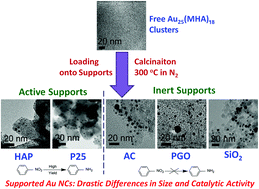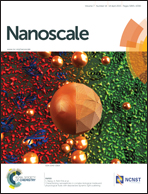The support effect on the size and catalytic activity of thiolated Au25 nanoclusters as precatalysts†
Abstract
In this study, 6-mercaptohexanoic (MHA) protected Au25(MHA)18 nanoclusters (or thiolated Au NCs) deposited on various inorganic supports, including hydroxyapatite (HAP), TiO2 (Degussa P25), activated carbon (AC), pyrolyzed graphene oxide (PGO), and fumed SiO2 were prepared via a conventional impregnation method. Following that, calcination under a N2 stream was conducted to produce surface ligand free, highly dispersed Au NCs catalysts. The effects of supports on the size and catalytic activity of Au NCs were systematically investigated. No obvious size growth was observed for Au NCs on HAP and P25 after thermally induced ligand removal, due to the strong interaction between the metal and the supports. However, severe aggregations of Au NCs were seen after thermal treatment on three other supports, including AC, PGO, and SiO2. The removal of surface thiol ligands from the Au NCs is crucial to catalyze nitrobenzene hydrogenation, where only calcined Au/HAP and Au/P25 exhibited good catalytic activity. On the other hand, all the supported Au NCs were active for the styrene oxidation, where Au/HAP exhibited the best catalytic performance. Altogether, both the size effect and metal–support interaction are crucial for the design of supported Au NCs as efficient catalysts for targeted reactions.

- This article is part of the themed collection: Editor’s Choice: Nanomaterials for catalysis

 Please wait while we load your content...
Please wait while we load your content...